This article was written exclusively for Investing.com
- Cheniere Energy processes natural gas into LNG plus owns infrastructure
- Energy companies have lagged broader stock market and energy prices since the 2020 lows
- LNG shares more than tripled since the 2020 low
- European and Asian demand supports higher LNG share prices
- Earnings an issue, but analysts love LNG shares
Oil and gas companies have not done as well as the commodities themselves since the 2020 lows. In April 2020, crude oil fell below zero before powering higher to its most recent peak at $85.41 on the nearby NYMEX futures contract in late October. As crude oil tends to take the stairs higher and an elevator shaft to the downside, late November saw a rapid price drop, with the price dipping below the $63 level on Dec. 2—oil's lowest price since late August—before crude rebounded to trade currently at around $71.
Natural gas fell to a quarter of a century low at $1.432 per MMBtu before powering higher to hit $6.466 in early October 2021, the highest price since February 2014. NYMEX natural gas reflects the energy commodity’s price at the Henry Hub in Erath, Louisiana. Late last week, the price fell to the $4 per MMBtu level as the 2021/2022 peak demand season in the US is just getting underway.
Over the past years, NYMEX natural gas was only available in the domestic US market, limited to the reach of the pipeline network. However, technological advances in processing natural gas into LNG for export worldwide via ocean vessel have made the US a supplier to regions where the price is far higher. Cheniere Energy (NYSE:LNG) is a leader in the US liquefied natural gas business, and its shares have experienced significant growth since the March 2020 low.
Cheniere processes natural gas into LNG plus owns infrastructure
Cheniere is involved in a variety of aspects within the liquefied natural gas business in the United States. It owns and operates the Sabine Pass LNG terminal in Cameron Parish, Louisiana, and the Corpus Christi LNG terminal near Corpus Christi, Texas.
Cheniere also owns the Creole Trail pipeline, a 94-mile pipeline connecting the Sabine Pass terminal with various interstate pipelines. It also operates the Corpus Christi 23-mile pipeline that connects the Corpus Christi terminal with intrastate natural gas pipelines.
As well, the company markets LNG and natural gas in the US and worldwide.
Energy companies have lagged broader stock market and energy prices since the 2020 lows
In 2020, natural gas traded to a low of $1.432 per MMBtu. While the price dropped from a high of $6.466 on the continuous NYMEX futures contract in early October to the $4.10 level as of Dec. 3, a 36.6% decline, and has fallen even lower since, it remains nearly triple the level seen in June 2020.
Crude oil fell from a high of $85.41 to the $66.26 level at the end of last week, a 22.4% drop. Still, it remained well above the April 2020 low when it fell below zero.
The S&P Energy Sector SPDR Fund (NYSE:XLE) is an ETF that holds shares in the leading US oil and gas-related companies. 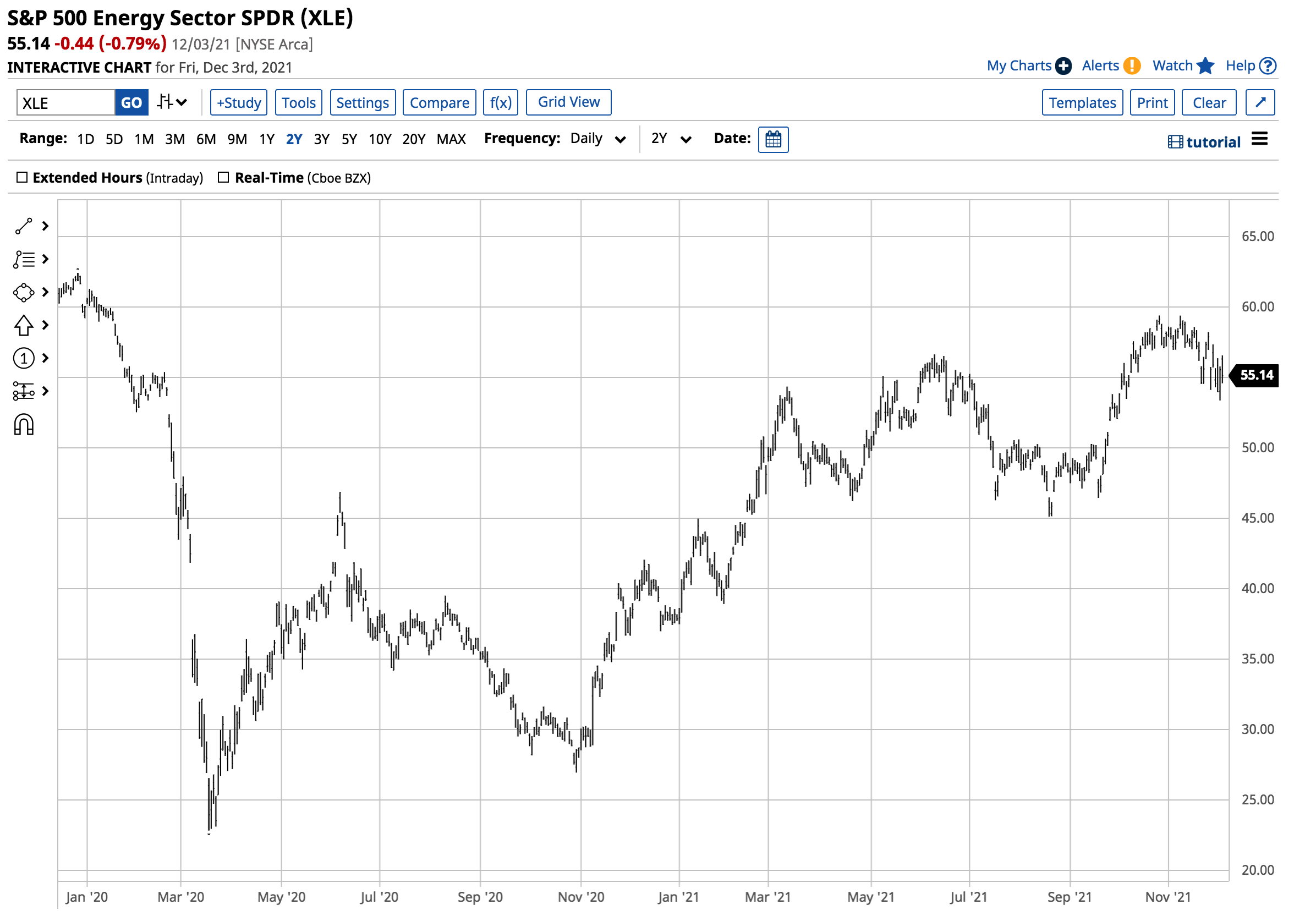
Source: Barchart
The chart shows that XLE rose from $22.88 per share at the March 2020 low to $55.14 on Dec. 3, a 141% gain over the period; it's currently trading just a tad higher. Shares of Cheniere Energy did much better.
LNG shares more than tripled since the 2020 low
The steady growth of the US LNG business over the past years pushed Cheniere’s stock higher, outperforming the XLE and many individual oil and gas companies. 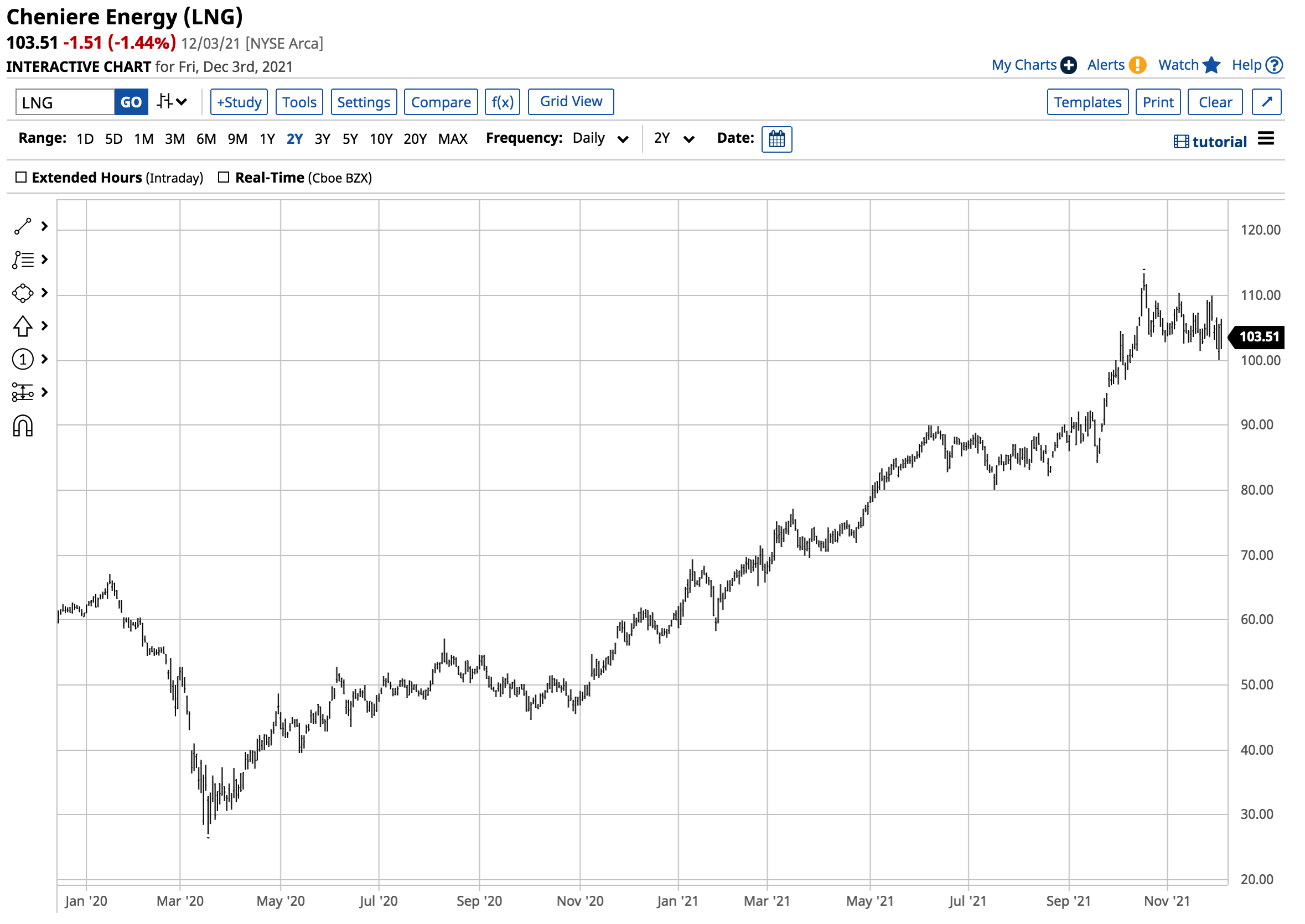
Source: Barchart
The chart above highlights the rise in LNG shares from $27.06 in March 2020 to the $103.51 level on Dec. 3, closing on Monday at $105.37, more than tripling in value over the period. At the mid-October $113.40 high, LNG was more than quadruple the price at the low.
European and Asian demand supports higher LNG share prices
The NYMEX futures price is a benchmark for US energy prices which can command steep premiums or discounts for different delivery locations through the continental US.
Meanwhile, European and Asian prices are many times higher than in the US. Cheniere’s business as a US exporter of liquid natural gas whose segments also include buying at US domestic prices, then processing the gas into liquid form, shipping it aboard and collecting higher prices from locations where gas is expensive, puts it in a unique position. As long as the price of gas and cost of processing and transportation are below the foreign prices, Cheniere profits handsomely.
The company continues to make substantial capital investments in its future as a leading LNG processor and supplier.
Earnings an issue, but analysts love LNG shares
In Q3 2021, LNG’s overall costs and expenses rose 300% to $5.55 billion compared to the same time in 2020. Analysts expected LNG to report $1.23 in earnings, but the numbers came in at a $4.27 loss. LNG’s track record hasn't been good, with the company missing analyst forecasts in three of the past four quarters.
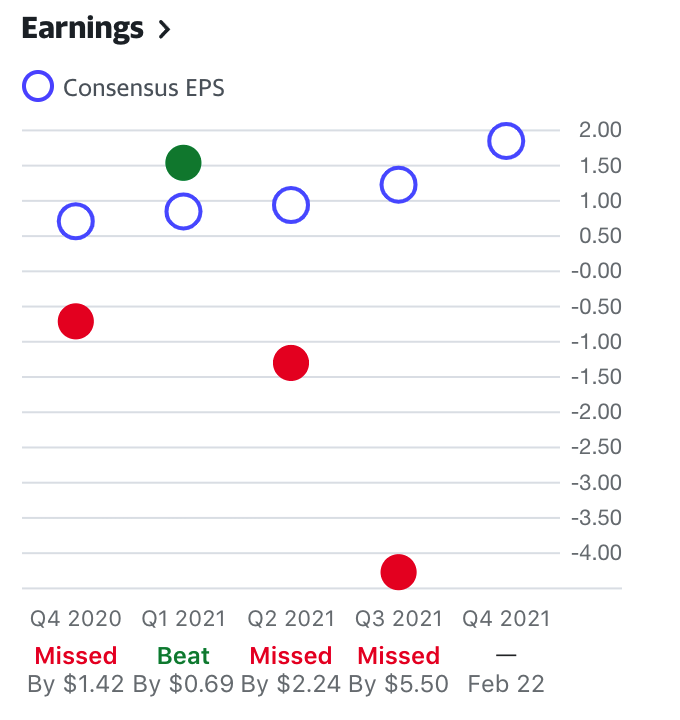
Source: Yahoo Finance
However, revenue has been growing, though the earnings trend has been negative because of capital investments.
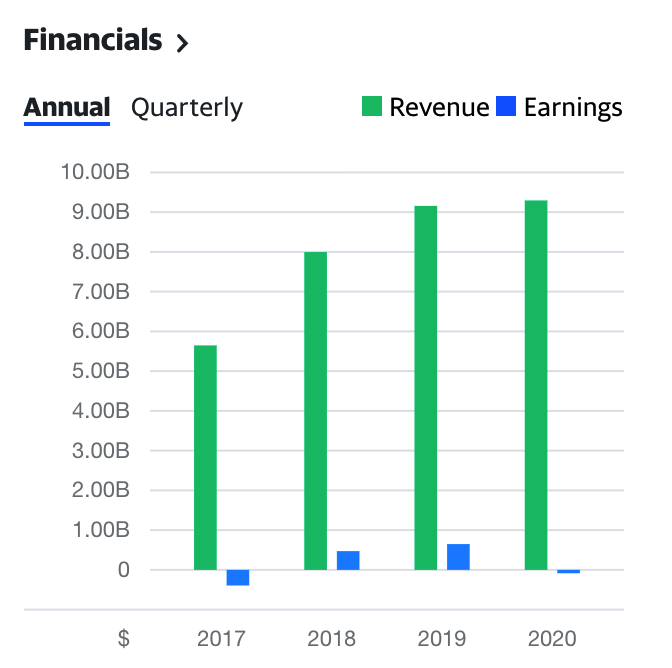
Source: Yahoo Finance
The chart shows the positive trend in revenues and negative path of earnings. The same trend continued from Q1-Q3 2021.
At the same time, analysts continue to love Cheniere’s prospects.
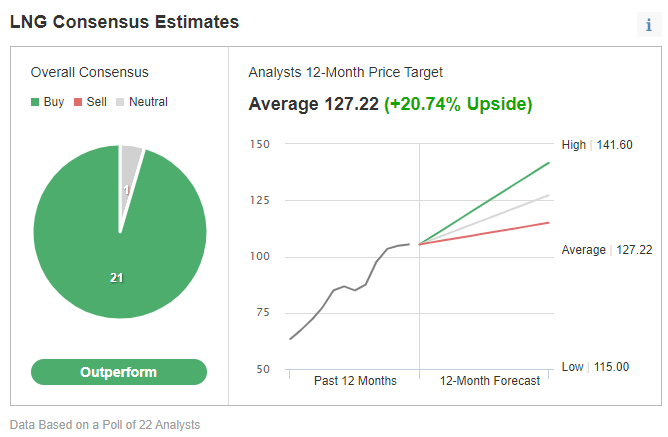
Chart: Investing.com
A survey of 22 analysts polled by Investing.com has an average 12-month price target of $127.22 for the stock, with forecasts ranging from $115 to $141.60. The majority of analysts polled provided an Outperform rating on the stock. At $105.37 on Dec. 7, LNG shares were about 8% below the low end of the range.
LNG pays shareholders a $1.32 annual dividend, translating to a 1.28% yield on the stock. With oil and gas prices under pressure, we could see LNG continue to correct over the coming weeks and months until it reports Q4 earnings in late February 2022.
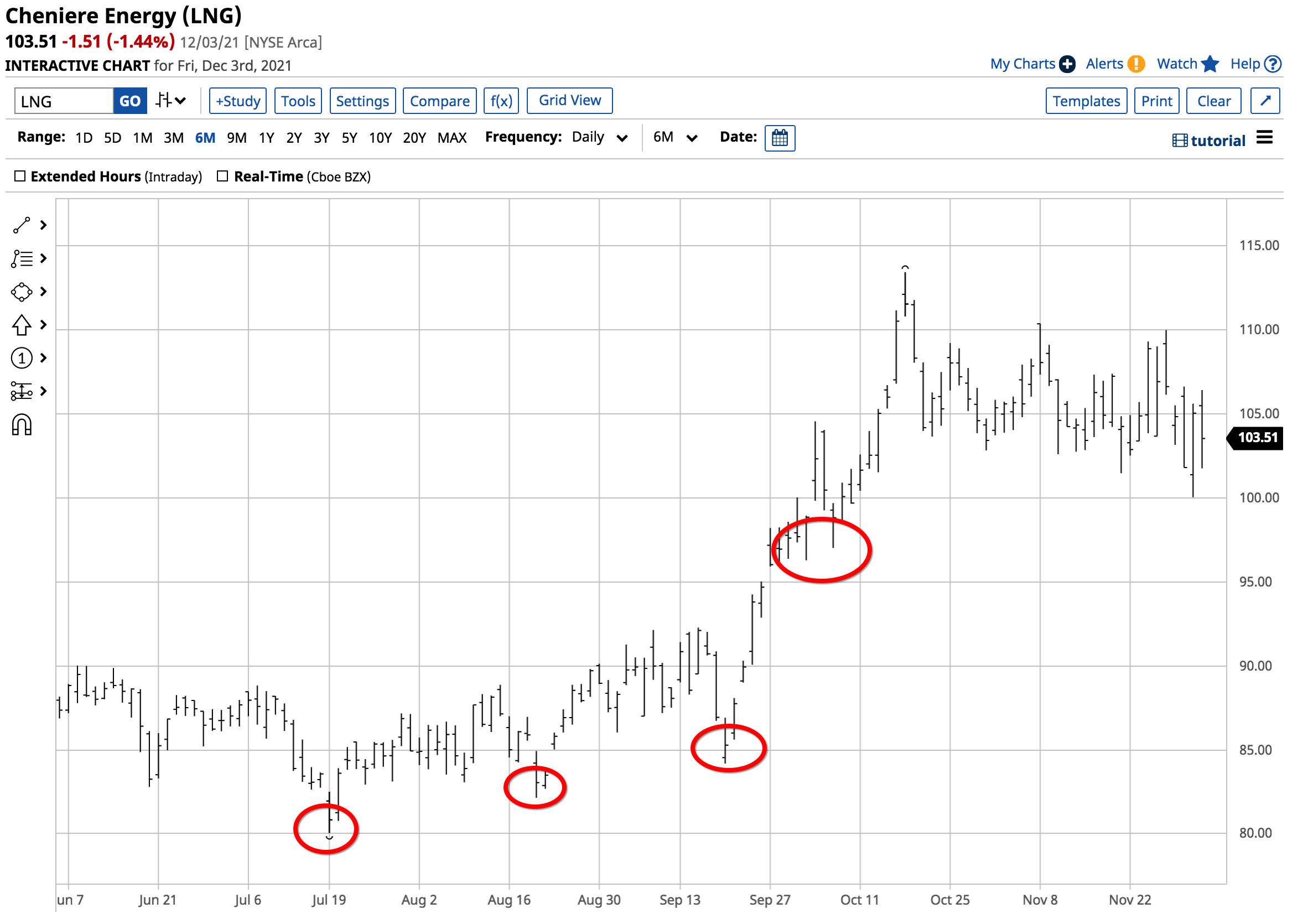
Source: Barchart
The chart shows the bearish pattern of lower highs and lower lows since LNG shares reached the $113.40 high on Oct. 18. Technical support is at $97, $84.19, $82.15, and $80.06 per share.
If the correction continues, buying the company that has a leadership role in the US LNG business could be the optimal approach for the coming years.
